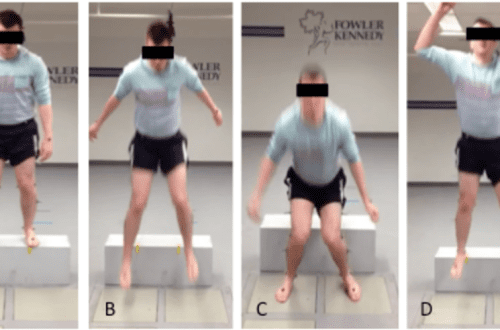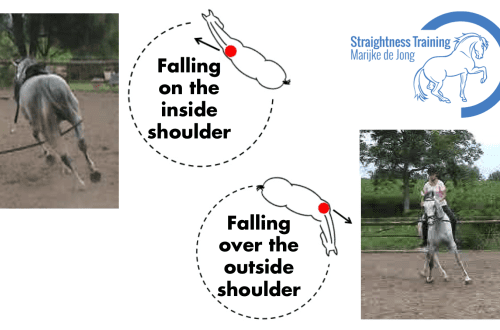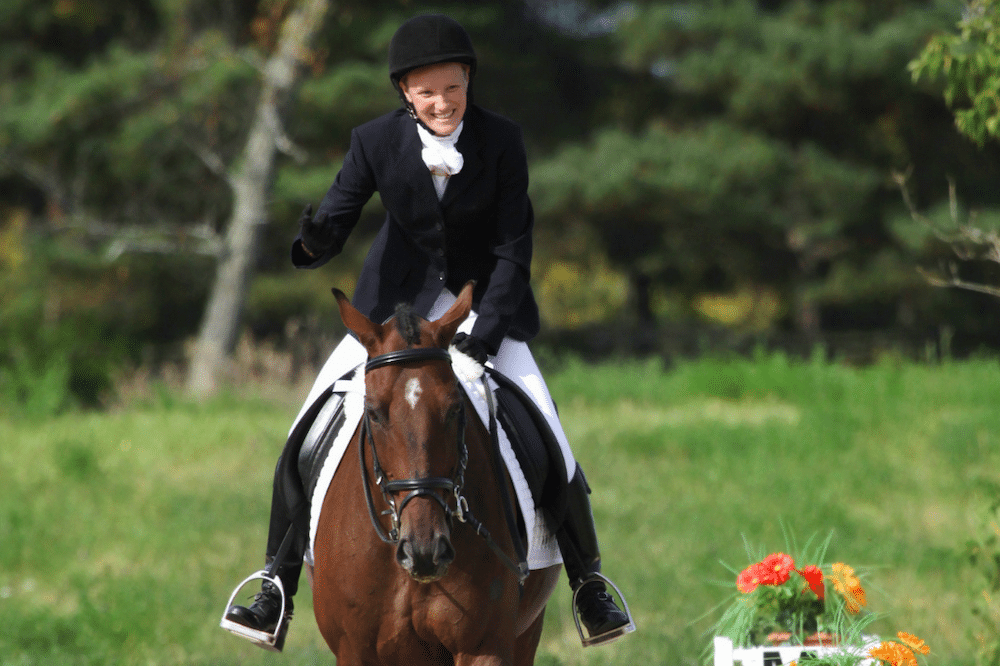
Dressage fit: Strive for perfection
Dressage fit: striving for perfection
Your seat is what allows you to feel and control your horse better. Working on a fit correction results in an increase in the performance of your ride as a whole. In this article we will look at the dressage landing – back to the very basics, remember the basic concepts and seemingly simple, but such important exercises.
U.S. Olympic champion show jumper Bill Steinkraus said, “Proper seating is what allows the rider to apply the controls with the precision of a surgeon.” And those words are especially true of your seat in a discipline like dressage.
So, during the stop, you should sit exactly on three points: two bones of the pelvis and the pubic bone. If you are properly aligned, an imaginary vertical line will run from your ear, over your shoulder, through your thigh, and down to your heel. Your body in relation to the horse’s back should form a right angle.
Do you sometimes feel like top-level riders sit a little “loose” with their shoulders behind their hips? This is due to the fact that the collected horse brings the hindquarters and his croup falls lower. This does not affect the right angle between the rider’s body and the horse’s back, but it does not keep the right angle between the rider’s body and the ground.
When you sit in the saddle, your lower back should maintain a natural curve. Firstly, it promotes relaxation, and secondly, it gives you a large range of motion in the waist area. Sitting with the natural curve of the lower back is easy. It is more difficult to achieve this on the move. You can invite a person who has never come close to a horse, dress him in expensive riding equipment, put him on a horse, adjusting his body, arms and legs, take a picture … and from the photo you will never understand that you are a beginner. But as soon as the horse starts moving, everything will change dramatically. Our “rider” will not be able to maintain his correct posture.
We can learn to follow the movements of our horse only by relentless training. And the best workout is doing exercises on the lunge, without stirrups and a reason.
Home
These exercises will allow you to develop a deep, balanced and relaxed three-point landing. By moving your arms while keeping your legs stable, or vice versa, by swinging your legs while calming your body and arms, you will achieve an independent position in the saddle.
Before you begin, make sure that the horse you will be riding is suitable for your purposes. She must be calm, adequate, have good correct gaits and be able to lunge. In addition, you will need an experienced cord assistant. The horse must be in a bridle, with a saddle and with elastic junctions.
For safety reasons, it is advisable to perform these exercises indoors or in a fenced arena. The rider must wear a helmet. Spurs are not allowed! A safety vest is optional and may interfere with your missions.
Some more difficult exercises will require you to have some skill in maintaining balance. The cord trainer should be aware that if you start to lean to the side, he will have to immediately bring the horse to a walk or stop it so that you can regain your balance.
Each of the exercises begins from the following position: the rider sits evenly in the saddle, his weight is distributed evenly, the outer hand rests on the front pommel, and the inner hand is wound behind the back, the legs hang down relaxed.
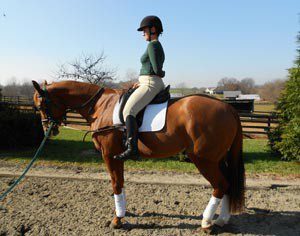
You can maintain this hand position when doing exercises that involve the legs.
In between exercises, or if you find yourself losing your balance, hold on to the pommel, but don’t grab the horse with your legs (any attempt to squeeze the horse with your legs will only result in you pushing yourself up out of the saddle). Pull your body forward to move it to the deepest point on the saddle.
Your ability to maintain your position in the saddle without wanting to secure yourself by holding on with your hands or “grabbing” with your feet will improve over time. By systematically exercising, you will acquire an independent and balanced posture that will not depend on your horse’s movements and that you will be able to maintain without stirrups and reins.
Try to keep the others uninvolved while working one part of the body.
Don’t rush, do things slowly.
Change direction every 10 minutes.
Depending on your physical form and the strength of the landing, do the exercises not only at the walk, but also at the trot and canter.
BASIC EXERCISES
1. Stop rotation. Start by rotating your feet. One, the other, two at the same time. In one direction, opposite, in a different direction with each foot.
2. We swing with a shankel. Trying to keep the body still from the knee and up, start swinging your shins in opposite directions. First left forward, right back, then left back, right forward. Try to keep the core and all other parts of the body not compensating for these movements and remain calm.
After completing each of the following exercises (starting with the third), you will need to align your position in the saddle.
3. Stretch the thigh muscles. Grab your foot with your hand and pull it towards your seat (your knee will be facing down). Alternate legs. If you feel pain, do not pull hard, do not bend your knee to the maximum, if you are not physically ready for this. Make sure that the body and pelvis are located in the saddle evenly and in the center.
4. Work on the inner thigh. Raise your arms and place them at shoulder level (airplane pose). Then, using both legs at the same time from the hip joints and below, try to tear them off the saddle and make a movement away from the side of the horse. At first, this will be difficult – you can put your legs to the side of the saddle just a couple of centimeters. As the muscles and ligaments become more elastic, you will be able to perform this exercise better. Watch the body, it should remain flat and straight.
5. Turning the body. Spread your arms at shoulder level (airplane pose). Make turns with the body so that the hands tend to align parallel to the horse’s body: one hand is directed towards the head, the other towards the croup. Try to reach to the limit, but make sure that the turn is carried out only in the lumbar region. The back and shoulders should be straight, the pelvis evenly placed on the saddle.
6. Circular movements of the hands. Make circular motions with your hands along your body. First with one hand, and then with the other, change the direction of rotation. Then, perform circular movements with both hands in one direction at the same time, then simultaneously, but in different directions (one hand moves clockwise, the other counterclockwise). Keep the body and shoulders straight, evenly distribute the weight on both legs.
WE COMPLICATE EXERCISES
For more confident riders, a more challenging training program can be offered.
Stop the horse. Place your outer hand on the front pommel of the saddle. Pass the inside leg over the pommel. You will be in ladies’ landing. Hold onto the pommel with your inside hand. Relax your legs, toes down.
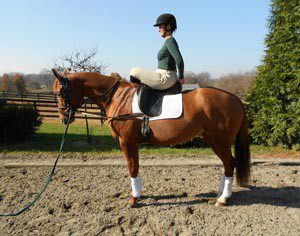
1. This exercise will allow you to perfectly center your position in the saddle. Your current position will not allow you to stay in the saddle by pinching the horse with your legs from both sides. If your body is not located strictly in the center and at its deepest point, you will slide down. It is better to start this exercise with a step, then you can try to perform it at a gallop. It is very difficult to deal with him at a trot, so leave the lynx for last. Don’t forget to change direction.
2. This exercise is generally reserved for riders working at Intermediate Prize and above programs.
The starting position remains the same as in the previous exercise. Now cross your arms over your chest and, bending at the waist, lean forward as far as possible. Your pelvis should stay in place and not rise. Then do back bends. To lift the body, use only the abdominal muscles. Work on the exercise at the walk, and then at the canter. At the trot, it is extremely difficult to perform. Do the exercise in both directions.
We included the last exercise in our article to demonstrate how much progress you can make. But remember, everything takes time. As a rule, at the first such training, riders do not feel quite comfortable, but after the third session, confidence comes to them. Remember that regular lunging will help shape your perfect dressage fit.
Jim Wofford; translation by Valeria Smirnova (source)




